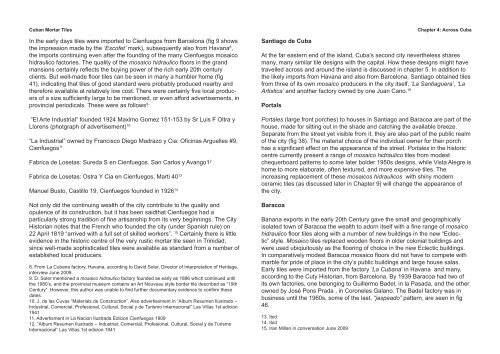Cuban Mortar Tiles - infogram.co.uk > Home
Cuban Mortar Tiles - infogram.co.uk > Home
Cuban Mortar Tiles - infogram.co.uk > Home
You also want an ePaper? Increase the reach of your titles
YUMPU automatically turns print PDFs into web optimized ePapers that Google loves.
<strong>Cuban</strong> <strong>Mortar</strong> <strong>Tiles</strong><br />
In the early days tiles were imported to Cienfuegos from Barcelona (fi g 9 shows<br />
the impression made by the ‘Es<strong>co</strong>fet’ mark), subsequently also from Havana 8 ,<br />
the imports <strong>co</strong>ntinuing even after the founding of the many Cienfuegos mosai<strong>co</strong><br />
hidrauli<strong>co</strong> factories. The quality of the mosai<strong>co</strong> hidrauli<strong>co</strong> fl oors in the grand<br />
mansions certainly refl ects the buying power of the rich early 20th century<br />
clients. But well-made fl oor tiles can be seen in many a humbler home (fi g<br />
41), indicating that tiles of good standard were probably produced nearby and<br />
therefore available at relatively low <strong>co</strong>st. There were certainly fi ve local producers<br />
of a size suffi ciently large to be mentioned, or even afford advertisements, in<br />
provincial periodicals. These were as follows 9 :<br />
“El Arte Industrial” founded 1924 Maximo Gomez 151-153 by Sr Luis F Oltra y<br />
Llorens (photgraph of advertisement) 10<br />
“La Industrial” owned by Francis<strong>co</strong> Diego Madrazo y Cia: Ofi cinas Arguelles #9,<br />
Cienfuegos 11<br />
Fabrica de Losetas: Sureda S en Cienfuegos. San Carlos y Avango1 2<br />
Fabrica de Losetas: Ostra Y Cia en Cienfuegos, Marti 40 13<br />
Manuel Busto, Castillo 19, Cienfuegos founded in 1926 14<br />
Not only did the <strong>co</strong>ntinuing wealth of the city <strong>co</strong>ntribute to the quality and<br />
opulence of its <strong>co</strong>nstruction, but it has been saidthat Cienfuegos had a<br />
particularly strong tradition of fi ne artisanship from its very beginnings. The City<br />
Historian notes that the French who founded the city (under Spanish rule) on<br />
22 April 1819 “arrived with a full set of skilled workers”. 15 Certainly there is little<br />
evidence in the historic centre of the very rustic mortar tile seen in Trinidad,<br />
since well-made sophisticated tiles were available as standard from a number of<br />
established local producers.<br />
8. From La <strong>Cuban</strong>a factory, Havana, ac<strong>co</strong>rding to David Soler, Director of Interpretation of Heritage,<br />
interview June 2009.<br />
9. D. Soler mentioned a mosai<strong>co</strong> hidrauli<strong>co</strong> factory founded as early as 1886 which <strong>co</strong>ntinued until<br />
the 1980’s, and the provincial museum <strong>co</strong>ntains an Art Nouveau style border tile described as “19th<br />
Century”. However, this author was unable to fi nd further documentary evidence to <strong>co</strong>nfi rm these<br />
dates.<br />
10. J. de las Cuvas “Materials de Construction”. Also advertisement in “Album Resumen Ilustrado –<br />
Industrial, Comercial, Profesional, Cultural, Social y de Turismo Internacional” Las Villas 1st edicion<br />
1941<br />
11. Advertisment in La Nacion Ilustrada Edicion Cienfuegos 1909<br />
12. “Album Resumen Ilustrado – Industrial, Comercial, Profesional, Cultural, Social y de Turismo<br />
Internacional” Las Villas 1st edicion 1941<br />
Santiago de Cuba<br />
At the far eastern end of the island, Cuba’s se<strong>co</strong>nd city nevertheless shares<br />
many, many similar tile designs with the capital. How these designs might have<br />
travelled across and around the island is discussed in chapter 5. In addition to<br />
the likely imports from Havana and also from Barcelona, Santiago obtained tiles<br />
from three of its own mosai<strong>co</strong> producers in the city itself, ‘La Santiaguera’, ‘La<br />
Artistica’ and another factory owned by one Juan Cano. 16<br />
Portals<br />
Portales (large front porches) to houses in Santiago and Bara<strong>co</strong>a are part of the<br />
house, made for sitting out in the shade and catching the available breeze.<br />
Separate from the street yet visible from it, they are also part of the public realm<br />
of the city (fi g 38). The material choice of the individual owner for their porch<br />
has a signifi cant effect on the appearance of the street. Portales in the historic<br />
centre currently present a range of mosai<strong>co</strong> hidrauli<strong>co</strong> tiles from modest<br />
chequerboard patterns to some later bolder 1950s designs, while Vista Alegre is<br />
home to more elaborate, often textured, and more expensive tiles. The<br />
increasing replacement of these mosai<strong>co</strong>s hidrauli<strong>co</strong>s with shiny modern<br />
ceramic tiles (as discussed later in Chapter 9) will change the appearance of<br />
the city.<br />
Bara<strong>co</strong>a<br />
Banana exports in the early 20th Century gave the small and geographically<br />
isolated town of Bara<strong>co</strong>a the wealth to adorn itself with a fi ne range of mosai<strong>co</strong><br />
hidrauli<strong>co</strong> fl oor tiles along with a number of new buildings in the new “Eclectic”<br />
style. Mosai<strong>co</strong> tiles replaced wooden fl oors in older <strong>co</strong>lonial buildings and<br />
were used ubiqiuitously as the fl ooring of choice in the new Eclectic buildings.<br />
In <strong>co</strong>mparatively modest Bara<strong>co</strong>a mosai<strong>co</strong> fl oors did not have to <strong>co</strong>mpete with<br />
marble for pride of place in the city’s public buildings and large house salas.<br />
Early tiles were imported from the factory ‘La <strong>Cuban</strong>a’ in Havana and many,<br />
ac<strong>co</strong>rding to the Cuty Historian, from Barcelona. By 1939 Bara<strong>co</strong>a had two of<br />
its own factories, one belonging to Guillermo Badel, in la Pasada, and the other<br />
owned by José Pons Prada , in Coroneles Galano. The Badel factory was in<br />
business until the 1960s, some of the last, “jaspeado” pattern, are seen in fi g<br />
46.<br />
13. Ibid<br />
14. Ibid<br />
15. Iran Millan in <strong>co</strong>nversation June 2009<br />
Chapter 4: Across Cuba



